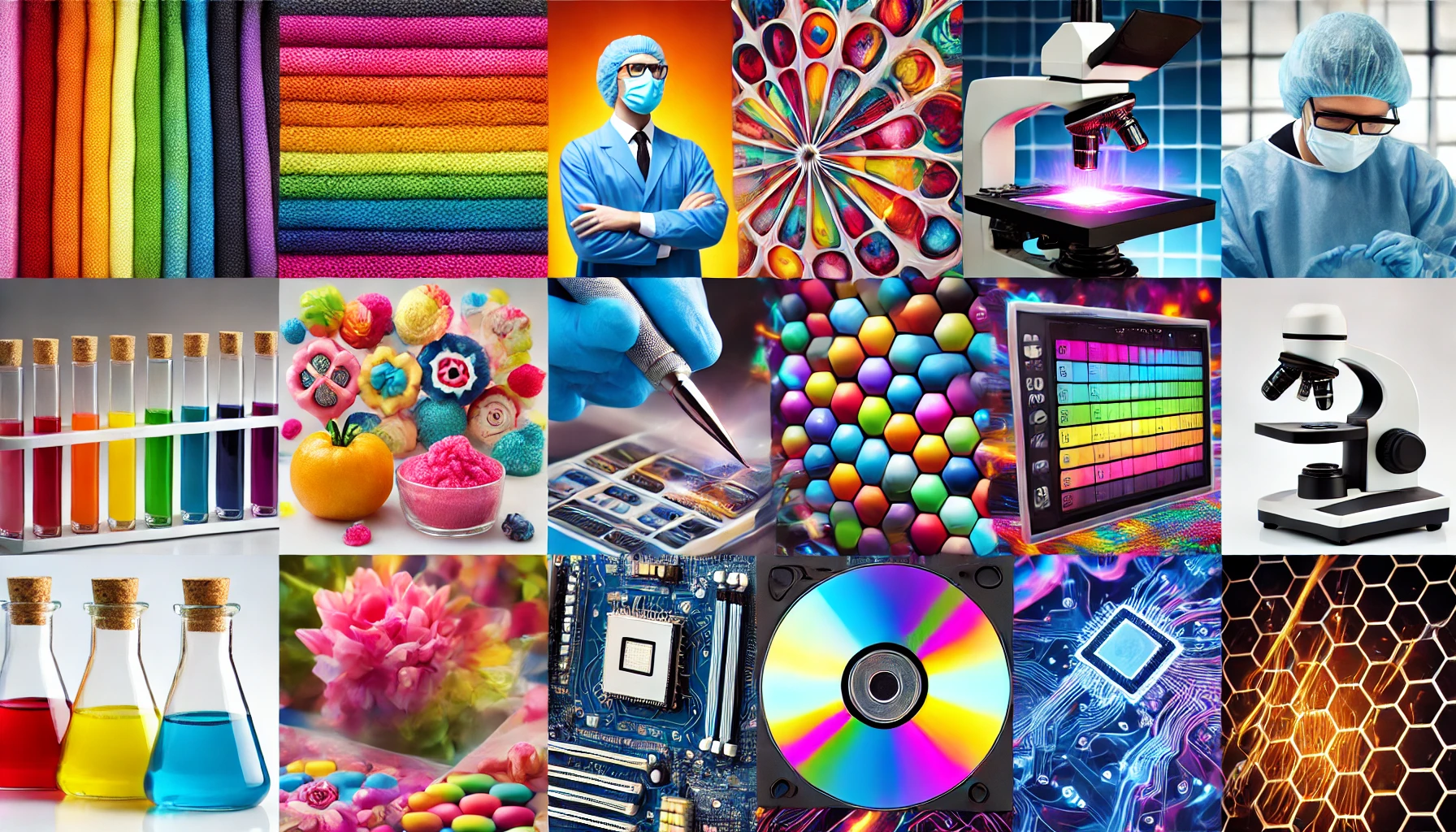Synthetic and fluorescent dyes play an important role in the textile industry, as well as in the medical, computer, and mechanical industries. Fluorescent dyes, in particular, are used in genetic research, dentistry, and cancer treatment due to their ability to emit bright light, and are environmentally friendly and recyclable, contributing to sustainability.
The development of chemistry has benefited humans in many ways. Seventy percent of the products we use on a daily basis have been derived from chemical technology. For example, the clothes we wear every day are made with petrochemical technology. Petrochemical technology also plays an important role in the production of many other household products, such as plastics, rubber, and synthetic fibers. In addition, books, paintings, fans, and more come in a variety of colors. How do they get those colors? It’s all thanks to the great invention of dyes. A dye is a substance that can impregnate fibers and other materials with color. Humans use dyes to dye many things into different colors. There are synthetic dyes and natural dyes, but synthetic dyes are more common nowadays. Synthetic dyes are not only used to create different colors, but also in other industries. Recently, a special synthetic dye, fluorescent dye, has been developed and is used in many fields.
The use of dyes isn’t just about color. They play an important role in art, culture, and industry. Since ancient times, people have used natural dyes to dye clothes and jewelry to express cultural and religious symbols. In modern times, the development of synthetic dyes has greatly increased the variety and stability of colors, opening up new possibilities for artists and designers.
First, let’s take a look at the history of synthetic dyes and how they’re made. Before the invention of synthetic dyes, natural dyes were used a lot, but they weren’t very useful because they could only be used to dye clothing. However, in 1856, an English chemist named William Henry Perkin succeeded in synthesizing the world”s first synthetic dye, Mauve. Since then, advances in organic synthetic chemistry have led to a variety of synthetic dyes. Synthesizing acid and aniline yields methyl oxygen (MO). The synthesis of synthetic dyes may differ slightly depending on the dye, but the process is generally similar. Therefore, the synthesis process of methyl oxygen is representative of the synthesis process of dyes. The dye intermediates used in the synthesis of methyl oxygen are acids and aniline, an organic substance. Under the right conditions, the acid and aniline combine to form methyl orange. Furthermore, if you want to dye this synthetic dye onto clothing, you need to use a direct dyeing method. This is done by adding the dye to a basic solution at high temperatures and then dipping the garment in it.
The advent of synthetic dyes revolutionized the textile industry by maximizing the efficiency of the dyeing process, offering a wide range of colors and a high degree of color consistency. This has made mass production possible, providing consumers with a wide range of colorful products at an affordable cost. In addition, synthetic dyes are durable and do not fade easily, making them an important material not only for apparel but also for a variety of other industries, such as automotive paint and building materials.

The fluorescent dyes introduced in the first paragraph can be obtained through a similar synthetic process. Fluorescent dyes are dyes that can emit light of the same wavelength after absorbing light. Because of this property, fluorescent dyes not only reflect light normally, but also emit more light of the same color, which is why they appear up to four times brighter. Because of their ability to emit bright light, fluorescent dyes are not only used in the textile industry, but also in other industries. First, the medical industry utilizes fluorescent dyes for their glowing properties. In genetics research, fluorescent dyes are injected into cells to find specific genes. Different genes emit different colors of light, making it easier to find what you’re looking for. Dentists also use fluorescent dyes to locate plaque in patients. The American Academy of Cosmetology has reported clinical trials with an imaging system that makes cancerous areas glow when infrared light is shone on them. Doctors can inject a patient with a tumor with a fluorescent dye, and then through an infrared camera, the glowing tumor area can be observed and treated. This technology is beneficial because it doesn’t affect the healthy cells surrounding the cancer. Second, the computer industry also uses fluorescent dyes. For example, the optical disks (CDs & DVDs) that we are familiar with contain fluorescent dyes. Also, printing inks are made with fluorescent dyes. These fluorescent inks are often used to print posters and advertisements. Thirdly, fluorescent dyes are used in the mechanical industry to see the flow of fluids in machines.
Fluorescent dyes are special dyes that cannot be found in nature, and they play an important role in the development of many industries and advanced technologies. According to recent studies, fluorescent dyes are environmentally friendly, recyclable, biodegradable, and harmless to the human body, which is why their demand is increasing due to the growing focus on sustainability. In particular, in 2024, a new fluorescent probe was developed that can observe the fluidity of intracellular lipid membranes in real time using fluorescent dyes. This probe is expected to become an important tool for cell biology research, as it can observe changes in lipid membranes during cell division in a non-toxic manner. In addition, ultra-bright fluorescent particles using mesoporous silica have been developed, which offer high brightness, low background signal, and excellent biocompatibility, making them a promising material for super-resolution imaging techniques (SpringerLink). These advances in fluorescent dyes are greatly expanding their application possibilities in a variety of fields. As such, fluorescent dyes are becoming important materials not only in the textile industry, but also in bioimaging, sensor technology, environmental protection, and many other industries. Research and development of fluorescent dyes is expected to continue in the future.